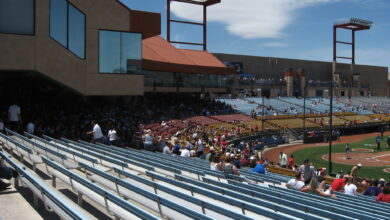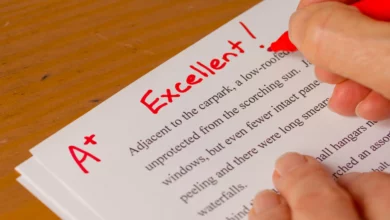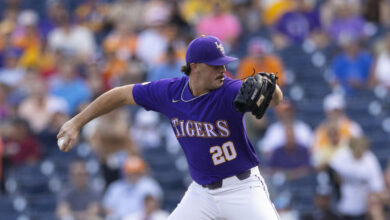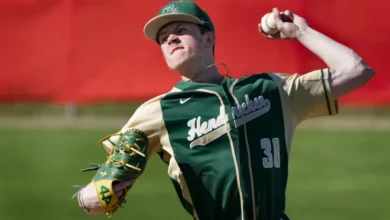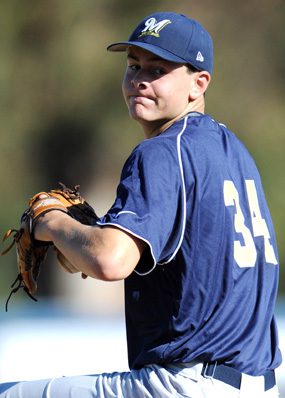
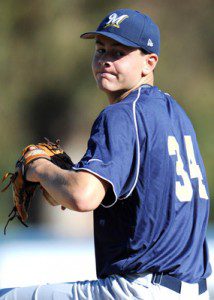
Never in the 47-year history of the amateur baseball draft has a high school right-handed pitcher been selected first overall. Come June 4, that may change. Lucas Giolito, a 6’-6”, 220-pound flamethrower from Harvard Westlake HS in Los Angeles, California, is the top prep pitcher in the country, and maybe the best in the entire country.
Scouts have been in love with him for years now. I mean, what’s not to like? He has the size to be a future workhorse in the majors. His mound presence and feel for the game is far advanced for his age. And then there is the fastball. The one that has already been clocked at 100 mph this season, in early February, when most players are still building their stamina and throwing motion from the offseason. His repertoire is much more than a fastball, however. His curveball and change-up are projected plus pitches, and he also throws a split-finger fastball just to keep hitters off balance. He went 9-1 as a junior last season, with a 1.00 ERA and 78 strikeouts over 70 innings. He allowed 42 hits and just one home run. This season, he already has thrown a complete game one-hitter, striking out eight over seven innings, walking none.
Now, before we consider this some amazing feat, consider that, in total, only two high school pitchers have gone first overall — both left-handers, obviously.
The first was back in 1973 when the Texas Rangers selected David Clyde, a 6’-1” hard-throwing pitcher out of Westchester HS in Houston, Texas. During his senior season, he went 18-0 with a 0.18 ERA over 148 innings. The 148 innings is what most high school pitchers today total over their careers. Bob Short, the owner of the Rangers at the time, drafted him solely as a novelty act to attract fans to the ballpark. Clyde definitely had talent, but the Rangers would end up doing him a major injustice. After those 148 innings dominating 16- and 17-year-olds, he was thrown directly into the big leagues at age 18 to face grown men. He went 4-8, with a 5.01 ERA, 1.71 WHIP and 74 K/54 BB over 93.1 innings that year. He was completely outmatched, and the experience no doubt crushed his confidence … as well as his arm.
Over five major league seasons, he would end up going 18-33, with a 4.63 ERA, 1.53 WHIP and 228 K/180 BB over 416.1 innings. It is noted that arm problems ended his career, when in actuality, it was his own organization. Clyde didn’t have a chance, he was set up to fail from the beginning.
The only other high school pitcher to be selected first-overall was Brien Taylor. In 1991, the New York Yankees had the first pick in the draft after suffering their worst season since they were known as the New York Highlanders in 1912. Taylor was a 6’-3″, 200-pound wunderkind who struck out 213 batters over 88 innings as a senior at East Carteret HS in North Carolina. He was left-handed, his fastball hit triple-digits on the radar gun and, most importantly, Scott Boras was his agent.
Taylor was 20 when he started his pro career, a vast difference in physical maturity as compared to an 18-year-old Clyde. He had an extremely successful debut at single-A Fort Lauderdale, posting a 2.57 ERA and 1.16 WHIP with 187 K/66 BB over 161.1 innings. The Yankees thought they were looking at the next Dwight Gooden. He then followed that up with a less successful season at double-A Albany in 1993. While his 3.48 ERA and 150 strikeouts over 163 innings was still impressive given his age and the competition, his 102 walks allowed were a troubling sign. On December 18, 1993, a fight while defending his brother lead to a dislocated shoulder and torn labrum.
Over the next four seasons, never pitching above class-A ball, his numbers were simply amazing, but not in a good way. Over 108.2 innings, he walked a staggering 175 batters., including 43 over 16.1 innings in 1996. He had a 10.86 ERA, 2.60 WHIP and only 86 strikeouts over those four years. The fight played a huge part in ending his once-promising career, but he also later acknowledged that the pressure of living up to being the first-overall pick, as well as playing for the Yankees, made the stress too much.
So what does all of that have to do with Giolito? Maybe nothing. However, it does prove the recent hesitancy that occurs when teams are confronted with an opportunity to gamble on a high-profile prep pitcher. Most pitchers take time to develop. They all have fastballs and usually a curveball to complement it. Almost all lack a third offering, something that is vital in becoming a starting pitcher. The off-speed stuff is usually the last to develop. Add in throwing motions, mental make-up and trying to translate success at the next level, and suddenly scouting a pitcher turns out to be the hardest thing in all of sports. The overall success rate isn’t good.
In 2006, Clayton Kershaw, of Highland Park HS in Texas, was regarded as the best high school pitcher in the country. He went 13-0 his senior season with a 0.77 ERA and 139 strikeouts over 64 innings. He had a perfect game in the playoffs where he struck out every batter he faced. He was the Gatorade High School Player of the Year, the USA Today High School Player of the Year and was a 6’-4”, 215-pound lefty whose fastball hit 98 mph. The Royals had the first-overall pick and decided on Luke Hochevar out of the University of Tennessee. He went 15-3 with a 2.26 ERA and a school record 154 strikeouts his junior season. He was a 6’-5″, 220-pound righty who had three years of college under his belt. He was mature, mechanically sound and scouts were assured his game would translate to the next level. Over his five-year career, the now 28-year-old owns a 5.29 ERA and 1.40 WHIP. Kershaw was drafted seventh by the Dodgers. The 23-year-old owns a 2.88 ERA and 1.17 WHIP over his four-year career. He also was the NL Cy Young winner last season.
In the 2011 draft, Dylan Bundy and Archie Bradley, both from Oklahoma, were the consensus top two prep pitchers in the country. Bundy, a 6’-1”, 200-pound righty, went 11-0 with a 0.20 ERA and 158 K/5 BB over 71 innings at Oswasso HS. His fastball has hit 100 mph, and his curveball is a potential plus pitch. Bradley, a 6’-4” and 220-pound righty, went 12-1 with a 0.29 ERA and 137 K/11 BB over 71.1 innings at Broken Arrow HS. His fastball hits 98 mph and he already owns a plus curveball, a 12-6 hammer. Both had good mechanics, both appeared to have the mental make-up for future success, but both were high school pitchers.
The Pittsburgh Pirates held the first-overall pick and selected Gerrit Cole from UCLA. The 6’-5”, 220-pound righty with a canon arm. While some think his ceiling isn’t as high as either Bundy’s or Bradley’s, he was a three-year starter at a top baseball school. Like Hochevar, he is mature, experienced and the safer pick. Bundy went fourth overall to the Baltimore Orioles, while Bradley went seventh overall to the Arizona Diamondbacks. Whether or not Bundy and Bradley turn out to be another Kershaw remains to be seen.
The amateur baseball draft is the biggest crap shoot of them all. Out of the 47 players who have been selected first overall, not one has made the Hall of Fame. Thirteen former number-one overall picks in the NBA are in the Hall of Fame, and that isn’t including guys like Shaquille O’Neal, Tim Duncan, LeBron James and Dwight Howard, all of whom are assured to get in. In the NFL, 12 former number-one overall picks are in the Hall, not including Peyton Manning.
While Ken Griffey Jr., Alex Rodriguez and Chipper Jones, all first-overall picks, are locks for induction, the rate of success is few and far between.
Aside from the money, and we’re talking about a lot of it, where you go in the draft doesn’t matter. Albert Pujols was drafted in the 13th round by the Cardinals in 1999, and he turned out to be a nice player. And while the Cardinals may look like geniuses for drafting him, they also passed on him 15 times, taking guys like Chance Caple, Josh Teekel and Brent Spooner before him. In fact, 10 of the players they selected before Pujols have yet to reach the major leagues.
So, if Giolito becomes the first-overall pick by the Houston Astros on June 4, he will make history, and a lot of money. If he doesn’t, and falls between pick two and 10, he will still make a lot of money, he just won’t be an answer to some bar trivia. Where he gets drafted will have nothing to do with his success at the next level. If you can play, you can play.
And Lucas Giolito can play.


